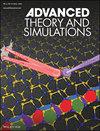Numerical Investigation of Eco‐Friendly All‐Zinc Based Thin Film Solar Cells For Sustainable Photovoltaics
IF 2.9
4区 工程技术
Q1 MULTIDISCIPLINARY SCIENCES
引用次数: 0
Abstract
In this numerical study, the performance of thin‐film solar cells comprising entirely Zn‐based layers is evaluated using SCAPS‐1D. ZnSnN₂ is chosen as the absorber layer due to its abundance on earth, and it has good optoelectrical properties suitable for photovoltaic (PV) applications. Its narrow bandgap and high absorption coefficient further enhance its suitability for such devices. The buffer layers explored in this study include ZnN, ZnON, ZnS, and ZnOS, all containing zinc. Likewise, the window layers examined are AZO, GZO, and ZTO. Nickel and Aluminium are used as the front and back contacts. A comprehensive analysis of each layer's properties and potential defects is conducted to improve the solar cell efficiency. The optimized device structure is determined to be Ni/ZnSnN₂/ZnON/ZTO/Al, achieving an efficiency of ≈19% with a short‐circuit current density (Jsc) of 20.05 mA cm生态友好型全锌基薄膜太阳能电池的数值研究
在本数值研究中,使用SCAPS - 1D对完全由锌基层组成的薄膜太阳能电池的性能进行了评估。由于znsnn2在地球上的丰度,因此选择它作为吸收层,并且它具有良好的光电性能,适合于光伏(PV)应用。其窄带隙和高吸收系数进一步增强了其在此类器件中的适用性。本研究探索的缓冲层包括ZnN、ZnON、ZnS和ZnOS,均含锌。同样,检查的窗口层是AZO、GZO和ZTO。镍和铝被用作前触点和后触点。为了提高太阳能电池的效率,对每一层的性能和潜在缺陷进行了全面的分析。优化后的器件结构为Ni/ZnSnN₂/ZnON/ZTO/Al,短路电流密度(Jsc)为20.05 mA cm−2,开路电压(Voc)为1.1 V,效率为≈19%。这些发现提出了一种新颖的、生态友好的、可扩展的、高效的薄膜太阳能电池设计,不同于用有毒和稀土材料制造的前身。
本文章由计算机程序翻译,如有差异,请以英文原文为准。
求助全文
约1分钟内获得全文
求助全文
来源期刊

Advanced Theory and Simulations
Multidisciplinary-Multidisciplinary
CiteScore
5.50
自引率
3.00%
发文量
221
期刊介绍:
Advanced Theory and Simulations is an interdisciplinary, international, English-language journal that publishes high-quality scientific results focusing on the development and application of theoretical methods, modeling and simulation approaches in all natural science and medicine areas, including:
materials, chemistry, condensed matter physics
engineering, energy
life science, biology, medicine
atmospheric/environmental science, climate science
planetary science, astronomy, cosmology
method development, numerical methods, statistics
 求助内容:
求助内容: 应助结果提醒方式:
应助结果提醒方式:


